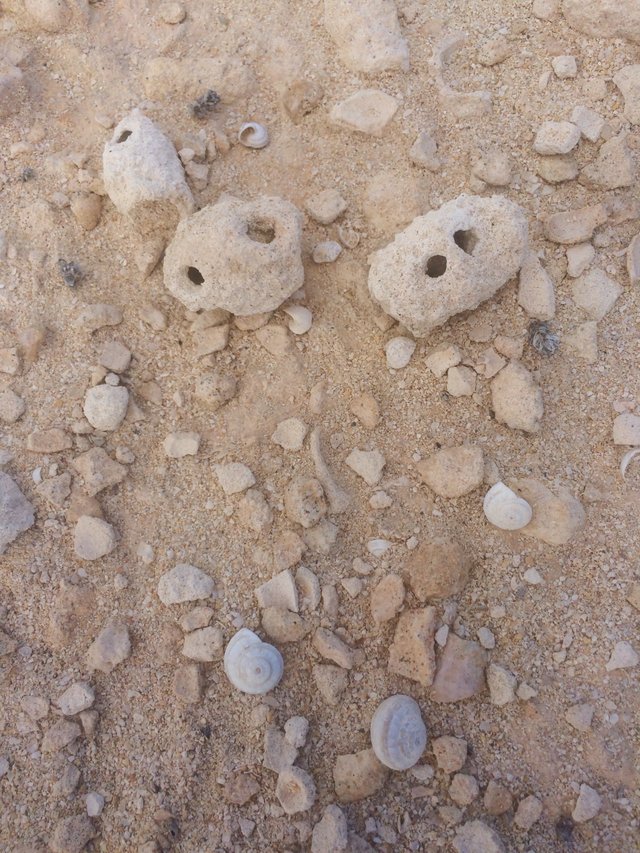The conditions are pretty arid and desert-like in Fuerteventura, so you might not expect to see much in the way of wild life on your visit. After a while exploring however, you'll be surprised to see the little creatures that gradually make themselves known to you!

In my previous post about Corralejo I mentioned the dunes that run alongside the beautiful Flag Beach and the little stone fortresses that have been constructed to shield from the heavy winds.

It is inside one of these that I spotted one of the most commonly sighted animal inhabitants of the island- the Haria or Atlantic Lizard.

Haria Lizard:
These guys are extremely friendly and curious about humans. You will first catch them spying on you from behind a rock, and then, once they know they have been seen they will crawl out and sprawl themselves out flamboyantly, soaking up the sun and showing off their beautiful green spots.

They are endemic to the islands of Fuerteventura and Lanzarote, and fully grown can reach as long as 25 cm. The young are light sandy brown in colour and very fast runners. As they grow older they become darker, with some adult males almost black with prominent green spots on their flanks and a jet black throat.
You are more than likely to spot lizards anywhere in Corralejo, especially in rocky areas, less commonly spotted are the cutest of wild mammals that I have discovered on the island-
Barbary Ground Squirrel:

These guys are not as easily found as their reptilian friends, I discovered them in a really unexpected place- the bus stop!
Yep, of all the places to congregate, these mischievous rodents seem to like socialising near the bus stop at the top of the town- clearly a good location for getting snacks from tourists.

They are extremely cute (almost like a cross between a meerkat and a chipmunk) and not at all afraid of people. They will run right up to you expecting food and will eat it right out of your hand.


The story of the Barbary squirrel is not unlike that of the Uk grey squirrel. They are not indigenous to this island, they are usually found on the coast of the Western Sahara- in Morocco, Algeria and the area of the Atlas Mountains.
They were brought to Fuerteventura over 4 decades ago as pets but have somehow managed to colonise the entire island! Some argue that they are an invasive species and have caused much damage to cultivations, native animals and plant life.
Such pesky critters! But it's hard to be mad at such cute little guys. Besides it's not their fault they were brought over and let loose into a country that has pretty much the exact environment as their native land. Of course they would prosper here!
There aren't too many birds in Corralejo, most likely due to the distinct lack of trees and greenery- there are however some sweet birds to be found on the beach, who seem to nest in the mounds on the dunes of Flag Beach.

I'm not sure what species these little guys are, they might be Kentish plovers, a breed known to breed on the shores of lakes, lagoons, and coasts, often populating sand dunes.
They are quite chubby and look very sweet quickly scuttling across the dunes, leaving their delicate little footprints all over the powdery sand.

There are other curious things to be seen on the dune, evidence of where creatures have been, mysterious signs that life has existed there once, but what?
There are hundred of these acorn sized stones all over the dunes, which are hollowed out and have uniform holes in them. Perhaps they have washed up from the oceans years ago and sea creatures used to be housed in them. If anyone knows, get in touch!

Now, some of you who have visited Corralejo may be wondering 'where are the goats?!' and you'd be right. Until recent years, goats outnumbered people on this island. The capital of Fuerteventura, today known as Puerto del Rosario, was even called Puerto Cabras (Port of Goats) for many years. A recent archaelogical dig unearthed goat skeletons dating back to 3000 years ago.

www.hiveminer.com
There are indeed masses of free running goats on the island, and I did spot them crossing a road together in a line, unaided by a shepherd or any human aid, but alas I didn't manage to get a photo of it.
Thanks for coming with me on a trip to meet the local creatures of Corralejo, I hope you enjoyed this post. If you did please upvote, comment, resteem and follow on @lolzwithlisa for more travel and vegan posts.

Meerkat Squirrels!!! Great post :)
Downvoting a post can decrease pending rewards and make it less visible. Common reasons:
Submit
Thanks! They were so cute 😊
Downvoting a post can decrease pending rewards and make it less visible. Common reasons:
Submit
Congratulations! This post has been upvoted from the communal account, @minnowsupport, by Lolzwithlisa from the Minnow Support Project. It's a witness project run by aggroed, ausbitbank, teamsteem, theprophet0, someguy123, neoxian, followbtcnews, and netuoso. The goal is to help Steemit grow by supporting Minnows. Please find us at the Peace, Abundance, and Liberty Network (PALnet) Discord Channel. It's a completely public and open space to all members of the Steemit community who voluntarily choose to be there.
If you would like to delegate to the Minnow Support Project you can do so by clicking on the following links: 50SP, 100SP, 250SP, 500SP, 1000SP, 5000SP.
Be sure to leave at least 50SP undelegated on your account.
Downvoting a post can decrease pending rewards and make it less visible. Common reasons:
Submit
@originalworks
Downvoting a post can decrease pending rewards and make it less visible. Common reasons:
Submit